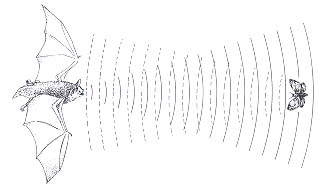
|
Echolocation |
Echolocation is a form of orientation that uses sound waves, rather than the light waves that are used in visual orientation. Very low frequency calls are emitted and, as the sound bounces off surrounding objects, they provide detailed information about the environment (even in the dark). All microbats have a sophisticated echolocation system, while megabats rely more on their visual system and keen sense of smell to find what they need.
| Insectivorous bats use echolocation to obtain information about the presence, position, course, speed, and even identity of potential prey. This incredible feat of precision works by measuring the time it takes for pulses of sound to travel to a target and back. Sound travels about 340m per sec in air, so the echo from an insect 1m away returns in about 3 millisecs8. |  |
When approaching obstacles or attacking flying insects, the pulse repetition rate increases. For example, the eastern red bat produces an echolocation pulse every 200 millisecs when searching for prey, but one every 5 millisecs in the final stages of the attack15. This is termed ‘frequency modulation’ and ensures that bats do not become blind to a nearing target.
Echolocation calls are vocalizations which are produced in the larynx (voice box) and then emitted through the mouth or the nostrils. Many bats emit calls that have a frequency below 20kHz (ultrasound) which unfortunately means that they are inaudible to humans. But we can draw bat 'songs' on a sound graph (called a spectrograph). Click here to view a spectrograph of bat song.
The evolution of echolocation is particularly relevant to the modern debate over chiropteran origins. If echolocation was a feature of the last common ancestor to all living bats, then megabats must have lost this ability despite its clear advantages to a nocturnal, volant lifestyle20. But, while echolocation has many benefits, it also has costs. The most pronounced is that other Those who are able to hear the low frequency calls include potential predators, and prey. Some moths have evolved complex ears specifically for listening to bats. When such a moth hears these calls, it either escapes or cunningly emits a response sound to confuse the approaching bat4. So it is not an impossible scenario that megabats might have lost the ability to echolocate. The few species of megabats that do echolocate (i.e.Rousettus) live in dark caves and produce sound by a primitive tongue-clicking rather than by vocalization12. Moreover, since megabats tend to glean their food (taking food from surfaces such as vegetation or the ground)they would have to detect a hard target on a hard background and the echoes would arrive at virtually the same time. Thus echolocation may have been lost when this group became frugivorous. |







